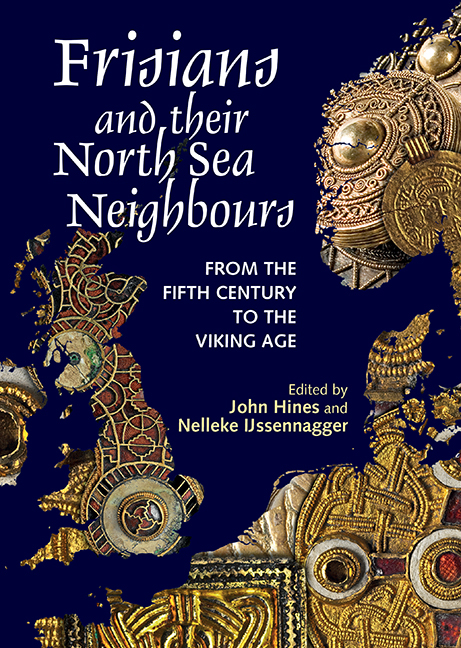Book contents
- Frontmatter
- Contents
- List of Figures
- List of Tables
- Preface
- Acknowledgements
- Linguistic Conventions and Abbreviations
- Abstracts
- Introduction: Frisians – Who, When, Where, Why?
- 1 Palaeogeography and People: Historical Frisians in an archaeological light
- 2 The Anglo-Frisian Question
- 3 Frisian between the Roman and the Early Medieval Periods: Language contact, Celts and Romans
- 4 ‘All quiet on the Western Front?’ The Western Netherlands and the ‘North Sea Culture’ in the Migration Period
- 5 Power and Identity in the Southern North Sea Area: The Migration and Merovingian Periods
- 6 How ‘English’ is the Early Frisian Runic Corpus? The evidence of sounds and forms
- 7 The Geography and Dialects of Old Saxon: River-basin communication networks and the distributional patterns of North Sea Germanic features in Old Saxon
- 8 Between Sievern and Gudendorf: Enclosed sites in the north-western Elbe–Weser triangle and their significance in respect of society, communication and migration during the Roman Iron Age and Migration Period
- 9 Cultural Convergence in a Maritime Context: Language and material culture as parallel phenomena in the early-medieval southern North Sea region
- 10 The Kingdom of East Anglia, Frisia and Continental Connections, c. ad 600–900
- 11 A Comparison of the Injury Tariffs in the Early Kentish and the Frisian Law Codes
- 12 Cultural Contacts between the Western Baltic, the North Sea Region and Scandinavia: Attributing runic finds to runic traditions and corpora of the Early Viking Age
- Index
1 - Palaeogeography and People: Historical Frisians in an archaeological light
Published online by Cambridge University Press: 25 August 2018
- Frontmatter
- Contents
- List of Figures
- List of Tables
- Preface
- Acknowledgements
- Linguistic Conventions and Abbreviations
- Abstracts
- Introduction: Frisians – Who, When, Where, Why?
- 1 Palaeogeography and People: Historical Frisians in an archaeological light
- 2 The Anglo-Frisian Question
- 3 Frisian between the Roman and the Early Medieval Periods: Language contact, Celts and Romans
- 4 ‘All quiet on the Western Front?’ The Western Netherlands and the ‘North Sea Culture’ in the Migration Period
- 5 Power and Identity in the Southern North Sea Area: The Migration and Merovingian Periods
- 6 How ‘English’ is the Early Frisian Runic Corpus? The evidence of sounds and forms
- 7 The Geography and Dialects of Old Saxon: River-basin communication networks and the distributional patterns of North Sea Germanic features in Old Saxon
- 8 Between Sievern and Gudendorf: Enclosed sites in the north-western Elbe–Weser triangle and their significance in respect of society, communication and migration during the Roman Iron Age and Migration Period
- 9 Cultural Convergence in a Maritime Context: Language and material culture as parallel phenomena in the early-medieval southern North Sea region
- 10 The Kingdom of East Anglia, Frisia and Continental Connections, c. ad 600–900
- 11 A Comparison of the Injury Tariffs in the Early Kentish and the Frisian Law Codes
- 12 Cultural Contacts between the Western Baltic, the North Sea Region and Scandinavia: Attributing runic finds to runic traditions and corpora of the Early Viking Age
- Index
Summary
The story of Frisia and the Frisians is one of a changing landscape, people, identity and name, as well as one of constant connections across the North Sea. For an understanding of the pre- and proto-historical Frisians and their archaeological traces, we first consider the changing landscape that they inhabited. We then look into the historical and archaeological sources that can tell us something about them, before turning to their connections across the North Sea.
The Frisian landscape and its use
In the course of recent millennia, the geomorphology of the Netherlands has seen major changes. An insight into the contemporary landscapes is indispensable to understanding the physical environment of the peoples who at different times considered themselves to be Frisians, or were so labelled by others, and what opportunities it offered. This was understood as early as the 16th century, when maps were drawn showing the Low Countries as they were believed to have been in the Roman Period. In recent decades an important research tradition has arisen in the Netherlands of compiling palaeogeographical maps, representing past landscapes on the basis of all available geological, paedological, archaeological and historical evidence. Such maps by definition are continually ‘work in progress’. Every new excavation revealing archaeological or geological evidence, as well as detailed studies of archaeological or historical data, prompts adjustments to them. But, broadly speaking, the current maps are well substantiated (Vos 2015).
Geographically, the coastal zone of historical Frisia in the Netherlands can be divided into two different parts: the Holland coast in the west, and the northern Netherlands (see also Dijsktra and de Koning, this vol.). In the west, the interior is protected by a sturdy belt of sand dunes. However, in the northern part of the west, most of the dune belt has been eroded away by the sea (Woltering et al. 1999; Dijkstra 2011). Initially, the mouth of the Rhine cut through the dunes at Katwijk, and further north a breach appeared at the Marsdiep, possibly in the 10th century ad. Although the Rhine mouth offered opportunities for controlling waterborne traffic, the great emporium of Dorestad evolved a considerable distance upstream (van Es 1990; van Es and Verwers 1980; 2009; 2015). The cores of what later became the islands of Texel and Wieringen consisted of Pleistocene boulder-clay outcrops.
- Type
- Chapter
- Information
- Frisians and their North Sea NeighboursFrom the Fifth Century to the Viking Age, pp. 5 - 24Publisher: Boydell & BrewerPrint publication year: 2017
- 1
- Cited by

